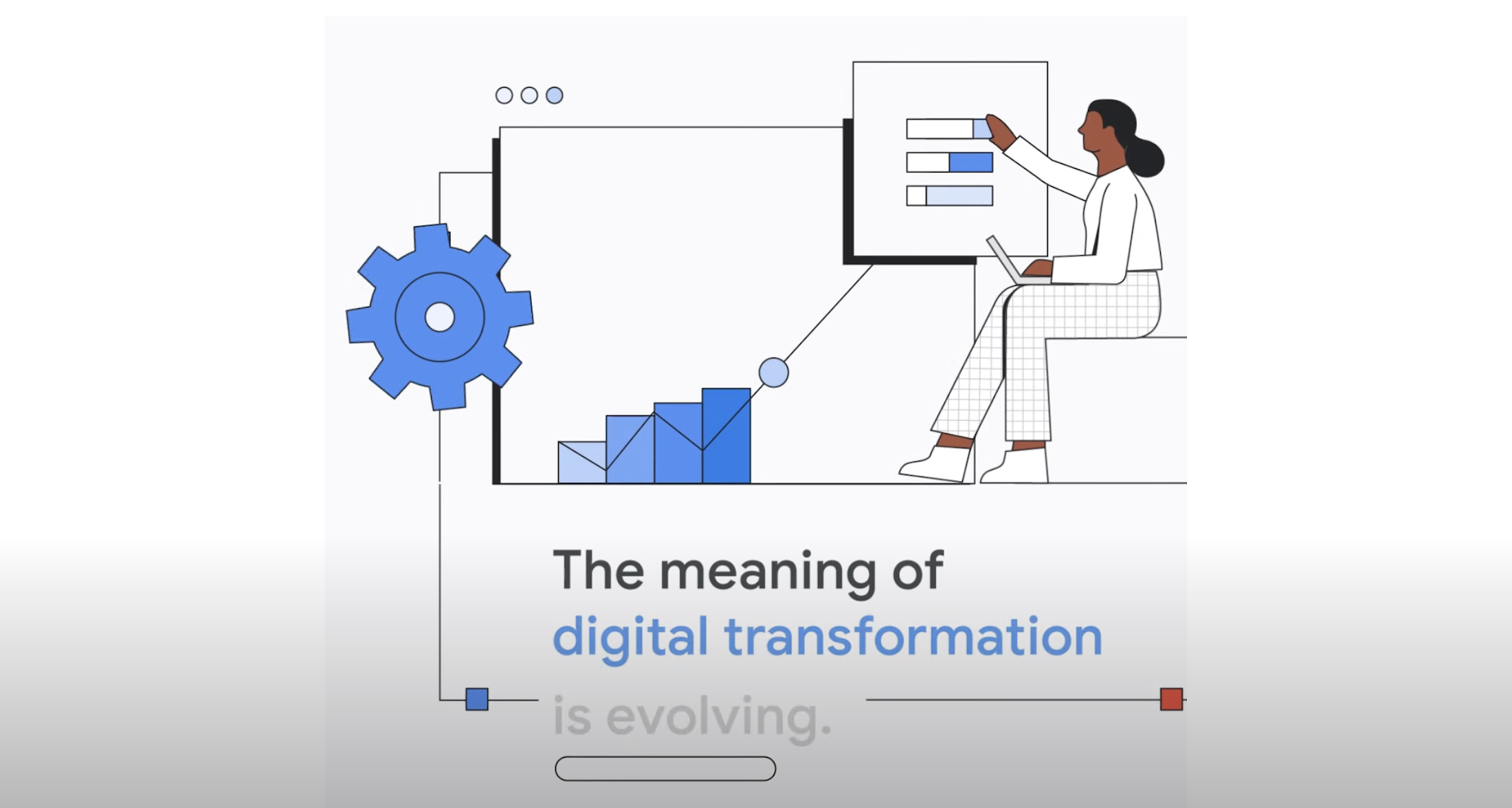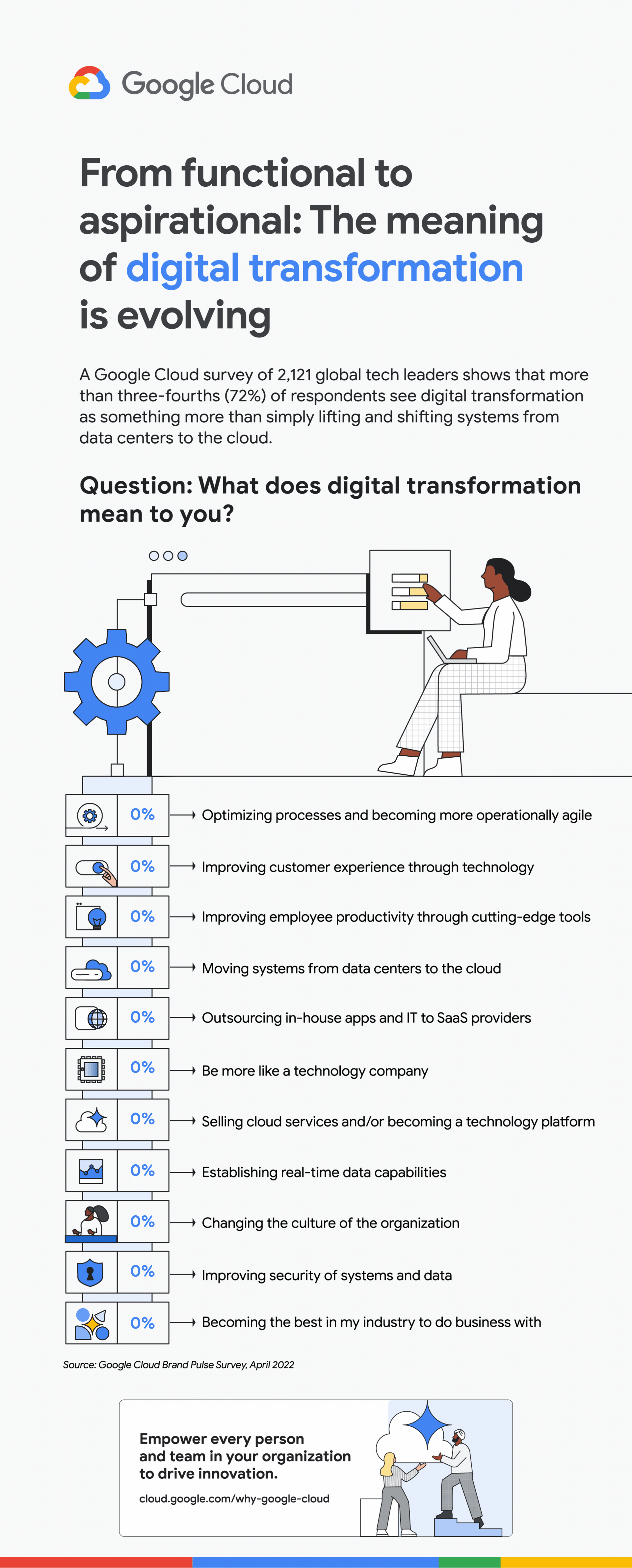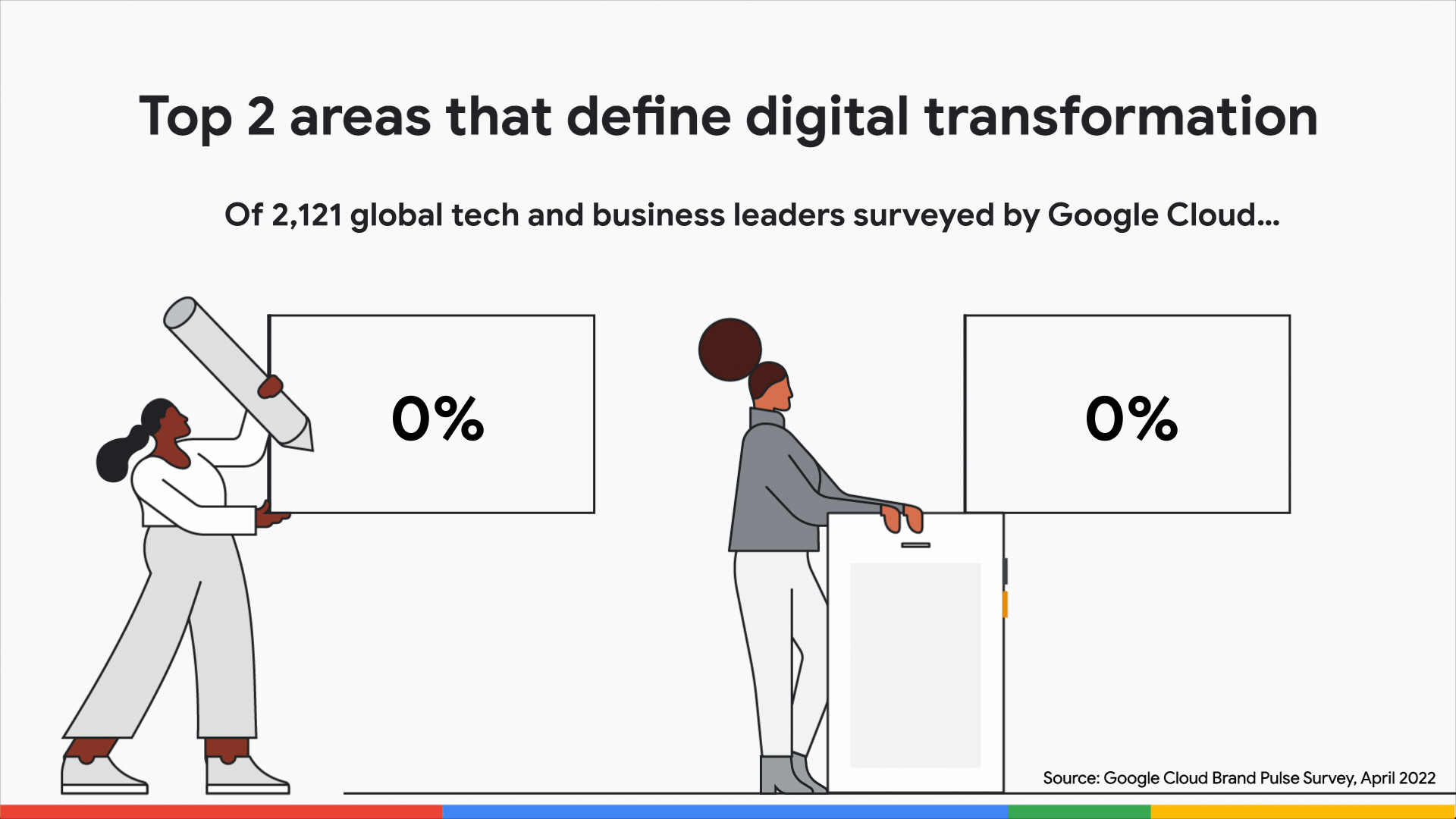You can teach a buzzword new tricks: Why the meaning of “digital transformation” is evolving

Blair Franklin
Contributing Writer, Google Cloud
Organizations are increasingly taking a more inspired look at the role of IT.
Here’s three things we know to be true:
1. The phrase “digital transformation” has a bit of a reputation for being overused corporate speak. (We know, we feel your eyes rolling as you read this).
2. We haven’t found a good replacement for it yet, either. (Cybernated? Transfiguration?)
3. The meaning of digital transformation is still important for modern organizations — so much so, it’s going through a transformation of its own.
The aperture of this buzzy business phrase is widening from functional to aspirational. Business imperatives such as agility, customer experience, and productivity enhancements have begun to eclipse more conventional infrastructure and cost considerations, according to a recent Google Cloud survey of more than 2,100 global tech and business leaders. The headline question: "What does digital transformation mean to you?"
Whether they're tired of the phrase or not, there's certainly more interest in digital transformation than ever, and what it means is changing: Nearly three-quarters (72%) of industry leaders view this practice as something more than a simple lift-and-shift exercise where systems are moved from data centers to the cloud.
Here’s what we learned in the April 2022 edition of the Google Cloud Brand Pulse Survey, which is conducted bi-monthly and among other things, gauges issues that are top of mind for cloud decision-makers.

Insight #1: “Digital transformation” is broadening — and that’s a good thing
Business and IT leaders are evolving their mindset about what it takes to stay competitive and innovative in a mercurial business landscape.
While 28% of survey respondents still hold a more traditional view of what it means to digitally transform, the outlook is broader for respondents who see the role of IT as evolving from that of “custodian” to “enabler.”


[Download the full infographic] When it comes to how leaders define digital transformation, business imperatives like agility, customer experience, and productivity enhancements have begun to eclipse more conventional infrastructure and cost considerations.
The data illustrates a noticeable about-face from a few years ago when technology leaders were more likely to characterize digital transformation as simply migrating their systems to the cloud and calling it a day. For instance, a 2018 McKinsey Global Survey found that 68% of respondents saw digitizing the organization’s operating model as the most common objective of digital transformations, and less than half said their target was launching new products or services or interacting with external partners on digital channels.
Similarly, a 2018 Gartner CIO Agenda Industry Insights report stated CIOs from 11 out of 15 industries were prioritizing “digital business/digital transformation,” indicating how innovation leaders still viewed transformations as synonymous with simply digitizing their business. At the time, the narrative focused on an urgent need to use technologies to digitize existing processes rather than considering how to use digital transformation to support loftier goals, such as improving customer experience or operational agility.
Today, there is a growing difference between digitalization and true digital transformation — a critical distinction in an era where every organization is now a technology company in some, if not every, way.
“Companies live or die, succeed or fail by their use of technology,” observes Paul Strong, a technical director in the Office of the CTO at Google Cloud and former CTO of VMware. “IT is no longer a supporting function. Real transformation is realizing that the opportunity is beyond the faster, cheaper, and more reliable mantra of the IT past.”
Insight #2: Process optimization and CX are at the heart of digital transformations
Globally across markets, technology leaders emphasized optimizing processes and becoming more operationally agile (47%) and improving customer experience through technology (40%) as the key components of digital transformation.


Becoming more operationally agile and improving customer experience through technology are key components of digital transformation.
These trends make sense given an unpredictable geopolitical landscape and macroeconomic environment where flexibility and adaptability are becoming critical survival traits. The data also reflects a clear move towards putting the customer at the center of digital transformation.
Digital capabilities are helping companies become more agile and make customers’ lives easier — something Strong has observed in his past roles serving on the digital transformation boards of industry-leading companies in the financial services and manufacturing sectors.
“What we’re seeing is a transition to an era that’s all about augmentation. You let the technology do the heavy lifting and leave the decision-making and the fine motor skills to the humans. This enables people’s ability to be so much more productive,” Strong continues. “And it’s not just about chatbots. We’re moving into a world where organizations are completely reimagining customer experiences so they can be more proactive in the engagement rather than waiting for someone to be unhappy.”
The increased focus on growth-oriented and customer-centric IT also ignites fundamental change within IT departments themselves. We’re now entering an era where CIOs and their teams are metamorphosing from supporters of the business to “customer dazzlers” who are “inextricably fused with the business in every conceivable way,” as Cloud Wars founder Bob Evans puts it.
“People are seeing strategy and inspiration in their technology as opposed to something they need to keep the lights on,” he tells us. “The promise of what the cloud can do for you is exploding. The posture has drifted to where IT leaders are embracing a new dawn of possibilities in terms of what they can unlock for their business teams, and how they can open up doors to new opportunities.”
Insight #3: The broadening definition of digital transformation also presents challenges


If there is going to be a genuine transformation, it is incumbent upon every business to define change in their terms and figure out what it means for all of their stakeholders.
Our survey results indicate that leaders are more stratified in their thinking, defining digital transformation in many ways.
These variations present new challenges for organizations as muddled definitions can lead to inconsistent approaches and ineffective roadmaps within the business. When executives and managers interpret the meaning of digital transformation differently, they inevitably fail to align around future goals and the steps needed to reach them. Boston Consulting Group research found that only 40% of all companies manage to create an integrated transformation strategy — a clear vision that includes strategic imperatives and quantified business outcomes.
Conflicting perceptions have a negative knock-on effect, resulting in unclear objectives and misalignment across teams and functions that can cause digital transformation initiatives to falter — or fail — before they have any significant impact. According to a Mckinsey survey, misinformed strategy and a lack of strategic clarity are the two most commonly cited obstacles that cause transformations to lose momentum or stall at the pilot stage.
This is why the challenges with transformation are actually more about people and not tech.
Large-scale, deliberate transformations require leadership to paint a vision of a future state that is compelling, and drive the culture to allow assumptions to be challenged and ideas to be pursued — inside and out.
Paul Strong, Technical Director, Office of the CTO, Google Cloud
“Culture is the biggest part of the journey for all businesses,” Strong observes. “Every journey is unique, and you have to have an idea of the destination. Large-scale, deliberate transformations require leadership to paint a vision of a future state that is compelling, and drive the culture to allow assumptions to be challenged and ideas to be pursued — inside and out.”
Digital transformation fatigue and disillusionment are also very real, and this is where some organizations get stuck in quicksand. If there is going to be a genuine transformation, it is incumbent upon every business to define change in their terms and figure out what it means for all of their stakeholders.
"Everyone wants to disrupt or reinvent an industry, or is looking for the next Google or Uber. But transformation is in the eye of the beholder, and that’s why clarity of mission and purpose are critical for transformation — especially in a time of uncertainty,” Strong says. "Ultimately, it is about new: new ideas, new ways of engaging, new definitions of value, and new business models like everything-as-a-service. It's about challenging and reimagining at all levels and scales. We don't always need industry-level disruption; we need the little things that add up, too.”
What’s clear is that organizations are increasingly taking a more inspired look at the role of IT and seeing it for the transformational outcomes it can engender, rather than a means to an end. And while the term itself could change in the not-too-distant future, its importance is here to stay.
Read this next: Develop a digital transformation strategy in a constantly changing landscape. Download the free report, “The Keys to Scaling Digital Value,” which is based on the responses of nearly 2,000 companies across 18 countries.



